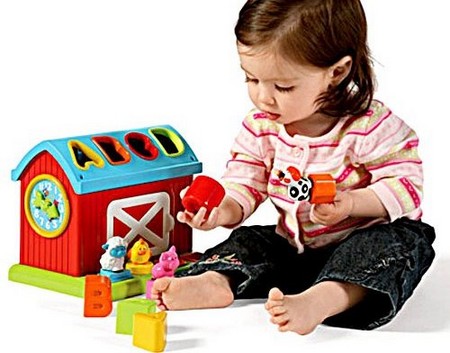Best Way to Choose Suitable Toys to Stimulate Your Child’s Learning Ability
Play and learning are connected in three ways:
- Learning can occur directly through play. In exploratory play a child deliberately manipulates a toy in order to discover its qualities. This type of play allows your child to discover aspects of his immediate world. In play with such things as jigsaws, shape sorters, and matching activities, your child learns problem-solving skills.
- Learning occurs indirectly through play. A typical six-month-old child will want to play with any toy given to him. While he discovers how to play with it, he will probably put it in his mouth, bite it, lick it, smell it, and bounce it off the wall. Although the infant’s main attention is to play with the toy, these other actions teach him about texture, shape, weight, and size. This incidental component of learning has a major influence on a child’s intellectual abilities, particularly in the first few years of life.
- Learning occurs instrumentally when children are suddenly faced with a particular problem that they have to solve before their play can continue (for instance, learning how to climb a tree in order to search for dinosaurs).
The following guidelines will help you choose suitable toys to stimulate your child’s learning ability through play:
6 months
Your child will enjoy playing with rattles activity centers, and small toys that he can pick up in his hands—but they must not be too small, because at this age an infant still tends to put toys in his mouth. He will try hard to get hold of an object that is put just outside his reach.
12 months
A child of this age can imitate adult actions (such as banging two small wooden blocks together to make a loud noise). He will be fascinated by any object that rattles. Put a couple of wooden beads inside a small box, and shake it—your child is likely to open the box in order to find out what’s inside. This type of play stimulates a child’s interest in puzzles.
18 months
Your child will begin to show an interest in elementary shape sorters. Most good toy shops sell shape sorters with just one or two shapes in them. If an adult demonstrates how the shapes fit into the board, the child will try to imitate the action.
2 years
Your child enjoys stacking building blocks, one on top of the other; he may be able to build a tower of up to six or seven blocks before it falls over. He enjoys playing with a set of plastic nesting toys, the type that fit inside one another in a fixed sequence.
3 years
Your child’s interest in puzzles and shape sorters with up to seven or eight pieces in them continues. Games in which he has to sort objects, such as blocks, according to color, size, or shape may attract his attention—and build his learning skills at the same time.
4 years
Puzzles with up to twenty pieces often fascinate a child of this age. He will also enjoy crayons and paper. His drawings of mom or dad will probably include details such as eyes, hair, hands, and mouth.
Categories
Advertisements
Recent Articles
 How to Understand Bed Sizes – A Small Guide
How to Understand Bed Sizes – A Small Guide How to Select Some Must Have Kitchen Accessories
How to Select Some Must Have Kitchen Accessories Best Way to Change a Car Tire
Best Way to Change a Car Tire Best Way to Write an Affirmation
Best Way to Write an Affirmation Best Way to Take Charge of Your Financial Life
Best Way to Take Charge of Your Financial Life Best Way to Survive a Party When You Don’t Know Anyone
Best Way to Survive a Party When You Don’t Know Anyone Best Way to Stop Self Sabotaging Yourself
Best Way to Stop Self Sabotaging Yourself Best Way to Start Journal Writing
Best Way to Start Journal Writing Best Way to Speak with a Powerful Voice
Best Way to Speak with a Powerful Voice Best Way to Simplify Your Life
Best Way to Simplify Your Life Best Way to Respond to a Put-Down
Best Way to Respond to a Put-Down Best Way to Reduce Acne Breakouts
Best Way to Reduce Acne Breakouts Best Way to Recover from Dining Disasters
Best Way to Recover from Dining Disasters Best Way to Quit Your Job Gracefully
Best Way to Quit Your Job Gracefully Best Way to Make Your Own Website
Best Way to Make Your Own Website



Leave a Reply